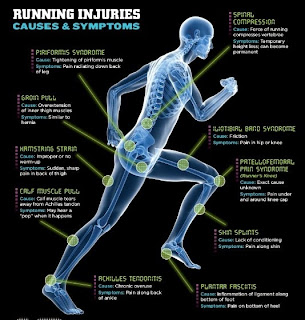Article contributed by: Claire Best
Any runner will know that familiar, gut-clenching feeling when you’re out for your run and feel a twinge in your foot, ankle or leg. The twinge that either signals a few days wearing it in a supportive brace or weeks out from your usual routine. Whether you’re new to running or are a seasoned pro, an injury and setback in your training is irritating at best, life changing at worst.
The usual suspects
Running can put a lot of strain on your joints. Your entire body weight is slamming down repeatedly on your lower body, sending shockwaves through your ankles and knees. Swelling under the knee cap is so common amongst runners that it’s received the title: ‘Runner’s Knee’. The pain of Runner’s Knee, like most injuries, can vary from dull to sharp and can occur anywhere within the knee. If the pain is dull, the runner should apply ice to the area and stretch the knee out gently, making sure to take a couple of weeks away from running. However, if the pain is intense and swelling extreme, or the pain lasts for longer than a few weeks, the runner should visit their GP (General Practitioner) as soon as possible.
Another area affected by running is the shin: the front of your leg below the knee. Shin splints are troublesome and notoriously reoccurring. This condition is characterised by a pain along the shin bone, which starts off as a dull ache that, if not rested, becomes intense. The rest period for shin pain is often only a couple of weeks. However, the more intense the pain and swelling gets, the longer the runner is likely to need to rest. Therefore, it’s vital that when a runner initially feels a pain anywhere, they should rest immediately.
Pain in the heel and Achilles tendon, the tendon at the back of the ankle and lower leg, and hamstring are also classic ailments to a runner. Massage, ice and rest combined are the best ways to treat it. However, as with any other pain, if it’s unbearably sore, it’s wise to visit a doctor rather than try and tough it out alone.
Prevention is the best cure
Warming up thoroughly before a run, as well as cooling down after, is the most effective way of preventing a typical runner’s injury. Stretching out your hamstrings, heels, and tendons against a wall or by laying on your back, bending one leg and gently pulling the other into your chest as far as your range of motion will allow is a beneficial way to get blood flowing the muscles so that they’re more flexible and can take the impact of running. Stretch out the other side of your leg – your quadriceps and shins – by using a wall or chair for stability, balancing on one leg and pulling the other into your glutes. It’s crucial not to force the stretch, or this can cause more harm than good.
Wearing the right shoes when running is also hugely beneficial for runners. It’s recommended that a runner invests in some specialised running shoes and not just regular trainers. Running shoes have adequate cushioning for stability, are light weight and can be tailored to whether you have a regular foot shape, flat foot or high arch. This will act like shock absorbers on a car so that they take the brunt of the vibrations you create when running and not your joints and ligaments.
Running technique is also imperative to consider when running. Head position, leg motion and even your shoulders have to all be taken into consideration when on your run. Overstriding, bouncing and not using your arms enough are all common mistakes in a runner’s stride, which contribute to putting too much pressure on the wrong areas and not adequately utilising others.
Getting back on the path
Injury can not only set a runner back physically, but mentally. The halt in progress and physical activity can be demoralising and in many cases can be a larger obstacle to overcome than the injury itself. An important step in getting over this is to make a plan. The runner should firstly visit GP to have their injury diagnosed so they can draw out a timeline of rehabilitation. Resting the injury so that it can heal is imperative to making a full recovery. Physical therapy, such as gently massaging, stretching and rotating the injured area stimulates the muscles and encourages blood flow to the area, which aids healing. After the initial rest period, while following doctor’s advice, the runner can then begin to slowly return to their normal routine; starting off slowly and gently, and only running short distances on familiar terrain is vital to not rushing and being detrimental to the healing process. The body uses a great deal of energy to heal an injury, so the adequate nutrition and calorie intake is also essential. Eating a substantial meal that’s high in carbohydrates, such as wholemeal pasta or sweet potato, a couple of hours before a run and ingesting a workout recovery drink afterwards is critical for healing, muscle recovery and growth.
Preventing a running injury for the most part is simple. Stretching, wearing the correct footwear and studying your running technique all contribute to keeping your joints, ligaments and muscles in full working order. However, sometimes you do get unlucky and when this happens a doctor should always be consulted first. Then, factors such as rest, ice, massage, nutrition and a slow, steady return to routine all help in achieving your physical best once again.


Mario Fraioli takes a look at the top-5 most troublesome running injuries and how to treat them. Jolene FairfieldLoree Fan
ReplyDelete
ReplyDeleteMassage Therapist has been successfully treating it’s clients since 2005, assisting in everything from injury recovery for athletes to providing relaxing massages to those that simply wish to indulge themselves.